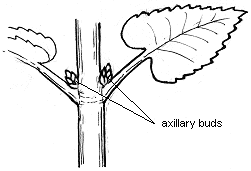
From Seed to Seed:
Plant Science for K-8 Educators
 |
From Seed to Seed: |
|
|
"... that thing that comes up from the ground that the leaves attach
to" Stems are the aboveground structures that bear the plant's leaves and flowers. The stem provides a host of services to the plant:
 stems have nodes along their length.
A node is the point at which a leaf attaches to the stem. The axillary buds
that we introduced you to during the photosynthesis discussion are located
at the nodes. (Remember that these buds, located just above where the leaf
meets the stem, sprout to form new leaves or side shoots.) The section of
the stem located between two nodes is called the internode.
The very tip of the stem where the most rapid growth usually occurs is called
the apical bud
(Gr. apex = highest point).
stems have nodes along their length.
A node is the point at which a leaf attaches to the stem. The axillary buds
that we introduced you to during the photosynthesis discussion are located
at the nodes. (Remember that these buds, located just above where the leaf
meets the stem, sprout to form new leaves or side shoots.) The section of
the stem located between two nodes is called the internode.
The very tip of the stem where the most rapid growth usually occurs is called
the apical bud
(Gr. apex = highest point).
Many familiar garden plants' stems are soft and green; these are called
herbaceous (her-BAY-shus)
stems. Examples include the stems of annu Stems contain vascular tissues-the "circulatory system" of the plant. Similar to our blood vessels, vascular tissues form an intricate network of veins that carry fluids throughout the plant. Large cells of the xylem (ZY-lem; Gr. xylon = wood) form a conduit for transporting water up from the roots. The smaller cells of the phloem (FLOW-em; Gr. phloos = bark) primarily transport sugars produced in the leaves, but are also involved in some water movement. In herbaceous stems, the xylem and phloem are contained in vascular bundles.  A plant's shoot system consists of its aboveground stems, plus any branches and leaves. Now let's put it all together... |
||||
|
Made possible by a grant from Oracle Corp. Copyright 2001, National Gardening
Association, Inc. For questions regarding this web site, contact Webmaster |